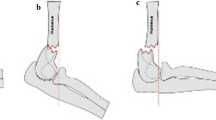Abstract
Background
Displaced paediatric supracondylar humeral fractures pose a significant risk of neurovascular injury and consequently have traditionally been treated as a surgical emergency. Recently, the need for emergency surgery has been questioned. We wished to analyse our experience at a large UK tertiary paediatric trauma centre.
Methods
A retrospective case note review was performed on patients with Gartland Grades 2 and 3 supracondylar fractures observed in a 2-year period from July 2008 to July 2010. We divided children into those treated before 12 h (early surgery) and after 12 h (delayed surgery). Analysis was undertaken using Fisher’s exact test.
Results
Of the 137 patients, 115 were included in the study; median time-to-surgery was 15:30 (range 2:45–62:50); thirty-nine children were treated before 12 h and 76 patients after. In the early surgery group, three children (7.7 %) developed a superficial pin-site infection, four children (10.3 %) required open reduction, five children (12.8 %) sustained an iatrogenic nerve injury, and two children (5 %) required reoperation. In the delayed surgery group, one child (1.3 %) had a superficial pin-site infection, four children (5.3 %) required open reduction, seven children (9.2 %) sustained an iatrogenic nerve injury, and two children (2.6 %) reoperation. Bivariate analysis of our data using Fisher’s exact t test revealed no statistically significant difference between early and delayed surgery groups with regard to infection rates (p = 0.1), iatrogenic nerve injury (p = 0.53) or need for open reduction (p = 0.44).
Conclusion
Our results indicate that delayed surgery appears to offer a safe management approach in the treatment of displaced supracondylar fractures, but it is important that cases are carefully evaluated on an individual basis. These results indicate that patient transfer to a specialist paediatric centre, often with consequent surgical delay, is a safe management option and also negates the obligation to carry out these procedures at night.
Similar content being viewed by others
References
Houshian S, Mehdi B, Larsen MS (2001) The epidemiology of elbow fracture in children: analysis of 355 fractures, with special reference to supracondylar humerus fractures. J Orthop Sci 6:312–315
Landin LA, Danielsson LG (1986) Elbow fractures in children: an epidemiological analysis of 589 cases. Acta Orthop Scand 57:309–312
Cheng JC, Shen WY (1993) Limb fracture pattern in different pediatric age groups: a study of 3,350 children. J Orthop Trauma 7:15–22
Cheng JC, Ng BK, Ying SY, Lam PK (1999) A 10-year study of the changes in the pattern and treatment of 6,493 fractures. J Pediatr Orthop 19:344–350
Brubacher JW, Dodds SD (2008) Pediatric supracondylar fractures of the distal humerus. Curr Rev Musculoskelet Med 1:190–196
Mehlman CT, Strub WM, Roy DR, Wall EJ, Crawford AH (2001) The effect of surgical timing on the perioperative complications of treatment of supracondylar humeral fractures in children. J Bone Joint Surg Am 83(A):323–327
Gupta N, Kay RM, Leitch K, Femino JD, Tolo VT, Skaggs DL (2004) Effect of surgical delay on perioperative complications and need for open reduction in supracondylar humerus fractures in children. J Pediatr Orthop 24:245–248
Bales JG, Spencer HT, Wong MA, Fong YBS, Zionts LE, Silva M (2010) The effects of surgical delay on the outcome of pediatric supracondylar humeral fractures. J Pediatr Orthop 30:785–791
Sibinski M, Sharma H, Bennet GC (2006) Early versus delayed treatment of extension type-3 supracondylar fractures of the humerus in children. J Bone Joint Surg Br 88:380–381
Carmichael KD, Joyner K (2006) Quality of reduction versus timing of surgical intervention for pediatric supracondylar humerus fractures. Orthopedics 29:628–632
Walmsley PJ, Kelly MB, Robb JE, Annan IH, Porter DE (2006) Delay increases the need for open reduction of type-III supracondylar fractures of the humerus. J Bone Joint Surg Br 88:528–530
Ramachandran M, Skaggs DL, Crawford HA, Eastwood DM, Lalonde FD, Vitale MG, Do TT, Kay RM (2008) Delaying treatment of supracondylar fractures in children: has the pendulum swung too far? J Bone Joint Surg Br 90:1228–1233
Yildrim AO, Unal VS, Oken OF, Gulcek M, Ozsular M, Ucaner (2009) Timing of surgical treatment for type III supracondylar humerus fractures in pediatric patients. J Child Orthop 3:265–269
Loizou CL, Simillis C, Hutchinson JR (2009) A systematic review of early versus delayed treatment for type III supracondylar humeral fractures in children. Injury 40:245–248
Gartland JJ (1959) Management of supracondylar fractures of the humerus in children. Surg Gynecol Obstet 109:145–154
Mayne AIW, Perry DC, Stables G, Dhotare S, Bruce CE (2013) Documentation of neurovascular status in supracondylar fractures and the development of an assessment proforma. J Emerg Med 30:480–482
Bashyal RK, Chu JY, Schoenecker PL, Dobbs MB, Luhmann SJ, Gordon JE (2009) Complications after pinning of supracondylar distal humerus fractures. J Paediatr Orthop 29:704–708
Kelz RR, Freeman KM, Hosokawa PW, Asch DA, Spitz FR, Moskowitz M et al (2008) Time of day is associated with postoperative morbidity: an analysis of the national surgical quality improvement program data. Ann Surg 247:544–552
Komen N, Dijk J-W, Lalmahomed Z, Klop K, Hop Wim, Kleinrensink G-J et al (2009) After-hours colorectal surgery: a risk factor for anastomotic leakage. Int J Colorectal Dis 24:789–795
Conflict of interest
None.
Author information
Authors and Affiliations
Corresponding author
Rights and permissions
About this article
Cite this article
Mayne, A.I.W., Perry, D.C. & Bruce, C.E. Delayed surgery in displaced paediatric supracondylar fractures: a safe approach? Results from a large UK tertiary paediatric trauma centre. Eur J Orthop Surg Traumatol 24, 1107–1110 (2014). https://doi.org/10.1007/s00590-013-1292-0
Received:
Accepted:
Published:
Issue Date:
DOI: https://doi.org/10.1007/s00590-013-1292-0




